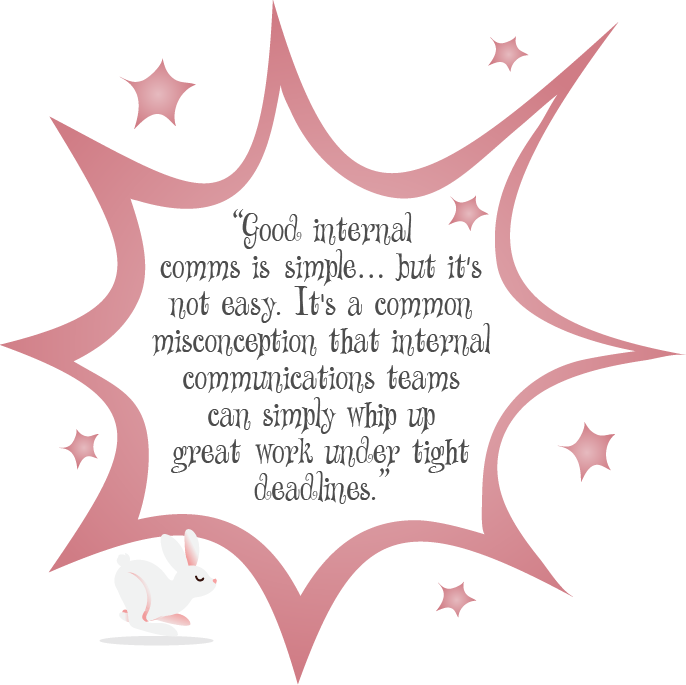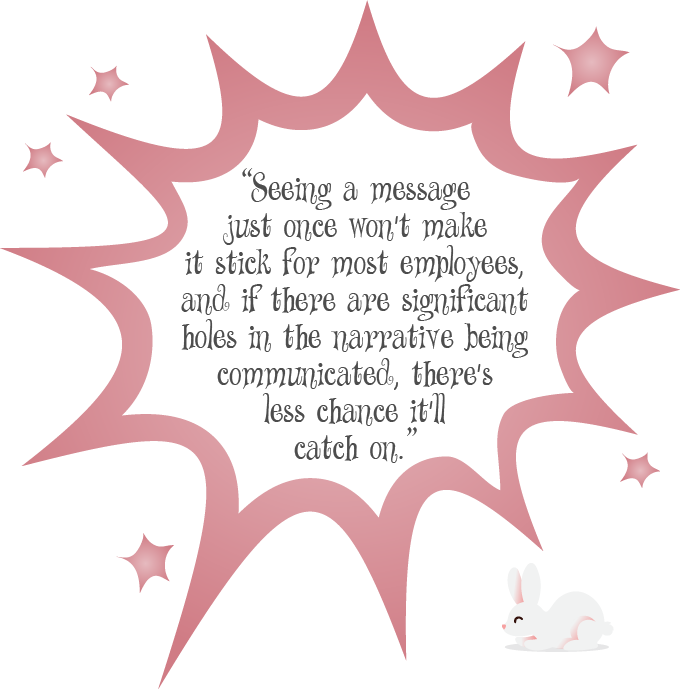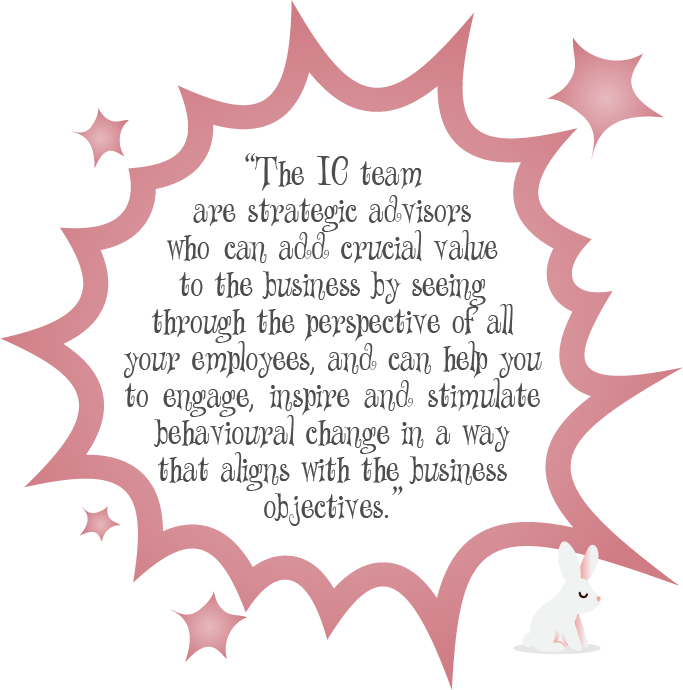


Our IC Consultant, the lovely Danae, debunks the myth of the Magic Comms Wand once and for all – and reveals some all-too-common missteps you may be guilty of that will prevent your internal comms team from adding true value to your business.
Are you guilty of misusing your organisation’s internal comms team?
What I mean by that is – have you ever helmed an exciting new internal initiative (let’s say, an organisational change or a business rebrand), but not thought about how you’re going to communicate it internally until it’s too late in the game, so you’ve had to enlist their help at the last minute to cobble together a workable communications strategy?
If this scenario is ringing bells for you, don’t worry, you’re not alone. This particular problem is one that faces internal communicators all too often.
Rather than being brought in at the start of the process to advise on communications strategies that will really have an impact on how employees respond and react to the initiative, they’re overlooked until being drafted in right at the end to come up with an amazing comms plan, with limited time and limited possibility to share and coordinate their expertise.


I’ve always said that good internal comms is simple… but it’s not easy. It’s a common misconception that internal communications teams can simply whip up great work under tight deadlines.
It all boils down to one core myth – that internal communicators come complete with a magic comms wand, that can be waved at will to fix such a situation almost immediately.
But sadly, such a wand doesn’t exist. Truly effective IC takes time, resource, skill, and a healthy amount of strategic and holistic thinking – and it certainly doesn’t help when the internal communicator’s specialty is underappreciated or misunderstood.
Read more: What does an internal communicator actually do? 12 internal comms professionals have their say
A lot of my time during my in-house career has often been spent simply advocating and educating people about the true value of internal communication; time that could have been devoted to enhancing important projects.
So for those of you most likely to work closely with internal communicators – department heads and senior leaders, HR or project teams – check out some of these common barriers that prevent internal comms teams from adding true value to your business.
Common barriers that prevent internal comms teams from adding true value to your business
Not including IC consultation at the beginning of projects/decision-making
People often come to the internal comms team too late in the game, expecting them to pull some exciting and compelling communications out of the hat as a last-minute knee-jerk initiative to ensure their project achieves buy-in and success with internal stakeholders.
They underestimate the time and effort required to make IC campaigns successful, leaving internal communicators with virtually no time to plan the messaging and target the right audiences, in the right order, through the right channels.
But more importantly, good internal communication is a process, and employees should be informed of new initiatives in various ways so that when a big launch or change occurs – you’ve already got them on board and helping to make it a success.
The IC team can only help create these effective plans if they know about them in advance – and put in some goals and measures in place so you can see the change your project makes!
Read more: 5 barriers to effective internal comms measurement
Trying to communicate before a project/initiative has taken shape


Another common ‘magic comms wand’ situation is when people come to the internal comms team expecting communications about their project to be broadcasted to internal stakeholders, before the project has actually been fully fleshed out.
Often, the context surrounding it is incomplete, leaving gaps in the narrative, or decisions have yet to be made about critical aspects and details that will need to be communicated to employees.
If internal comms professionals advise you to hit the pause button on sending out communications when they notice key information is missing, it’s not because they’re being unhelpful, or want you to miss your target or have your leader breathing down your neck.
Rather, they’re seeing the communications from the eyes of ALL employees, and are aiming to assess what may or may not already be widely understood about the initiative in question.
Seeing a message just once won’t make it stick for most employees, and if there are significant holes in the narrative being communicated, there’s less chance it’ll catch on.
Assuming that the internal comms team are simply operational in function
The IC team don’t just ‘send out stuff’ – they’re strategic advisors who can add crucial value to the business by seeing through the perspective of all your employees, and can help you (and other teams within the organisation) to engage, inspire and stimulate behaviour change in a way that most closely aligns with the business objectives.
Read more: Why it’s time Senior Leaders started switching on to internal communications


The position of internal communications function as a key strategic enabler within the business is often undervalued by senior leaders, and internal communication professionals have been fighting to change these unhelpful perceptions and increase the profession’s standing within organisations. The good news is that senior leadership appreciation and understanding of the value of internal comms is on the up, with 77% of practitioners now feeling that CEOs and MDs truly value the function. Woohoo!
If you’re a manager or senior leader, I’d strongly advise you to proactively go out and gain a deeper understanding of how your internal communications team can really help make you and your organisation stronger – both in terms of enhancing employee engagement, and in achieving your overarching business goals.
Considering internal communications as solely the responsibility of the internal comms team
It’s important to remember that IC doesn’t just fall into the remit of the internal comms team. As a leader, communication is an inherent part of your role and it’s something you should devote time to honing and mastering.
Helping leaders to communicate effectively is something we do a lot here at H&H, so if you feel you need a little help in enhancing your comms capabilities, drop us a line and we’ll be happy to share our expertise.
Ultimately though, before you come to the internal comms team with a project you need their help in shouting about, think about what you want to accomplish beforehand.
This means devising clear objectives for how you want the internal comms team to assist, consulting and working with them to decipher how to best achieve the outcomes you want through various communication tactics, and allowing them to lend their knowledge so you can devise a workable, sustainable, and well-considered strategy together.
Let the magic comms wands shine!
Meet the author

Our Danae – IC Consultant
My role combines my prowess and experience in strategic internal communications with my natural love of building relationships with others. Not only do I deal with clients directly on their day-to-day needs, but I also come up with inventive and practical solutions to their wider challenges alongside the rest of the team. That’s what gets me up in the morning – happy employees lead to equally happy customers, and at H&H I’ve got a unique chance to really make a difference to employees across the globe. And who wouldn’t be happy about that?
Get to know me better over on our team page or connect with me on Twitter or LinkedIn!
Want to learn more about how internal comms can take your business success to new and marvellous heights?

Our comprehensive IC Field Guide infographics are packed with facts, stats and figures, on topics like mastering employeee engagement through effective internal comms to how you should really be communicating change in your organisation to inspire the bottom line. Download your copies here and access all the latest, critical industry knowledge right at your fingertips!







